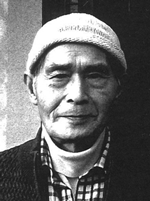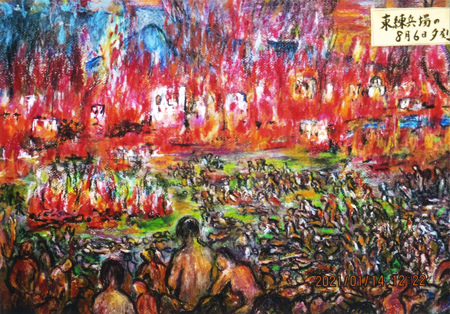A sudden flash
It was over 75 years ago.
August 6, 1945. The repeated air raid warnings from the night before had forced us to flee to an air-raid shelter many times, but early that morning, the siren of the warning alarm sounded, and we went into the shelter again.
It was 7:31am.
My sister, a third-grade student at a national elementary school who had returned home from an evacuation site, and I, a first-grade student, went to school together at an offsite classroom that had been established in the town.
As the air raids had become more intense, offsite classrooms were temporary classrooms that were set up in temples and private houses in each area so that students did not have to commute to the main school, which was a long distance away.
I attended the Kojin-machi National School Osuga offsite classroom, which was located in a rented private house near the west end of the current Shinkansen platform at Hiroshima Station.
My sister and I set about our morning cleaning and were wiping the front door area.
The bucket of water was dirty, so my sister went into the kitchen to change the water.
I may have sensed something, because I stopped and looked over the living room toward the garden.
At that moment, a huge flash of light covered the area.
I saw the leaves of the shrubs in the garden turn black and melt.
The next moment, the blast hit with a booming sound.
The pillars and ceiling came crashing down, and I was slammed into something, cowering in the pitch-black darkness.
I do not know how long I waited, but no one came to my rescue.
The smoke had subsided a little, and light began to leak in from above.
I realized that the ceiling had collapsed.
I crawled up desperately.
I ducked through a gap in the pillars, pushed something up, and struggled to get out, amidst the smell of rotting straw and dirt on the walls.
I emerged on top of the collapsed roof.
Strange looking people were fleeing down the street in front of me in a line.
When I looked around, I saw that all the houses had been destroyed.
I did my best to follow behind the stream of fleeing people.
Looking down from a slightly elevated place toward the railroad tracks, I could see that the stream of people was a long, long line of evacuees.
In a ditch, a horse was struggling on its back.
When we reached the road along the river next to Nigitsu Shrine, we could see the Hakushima area on the other side of the river, and people were coming down the stone steps leading down to the riverbed, like an avalanche.
I saw many people floating and sinking in the river.
I ran as fast as I could, trying to keep up with the flow of people.
Fire was spewing from the collapsed houses along the river.
I was running away from the rubble-strewn streets barefoot.
I think almost everyone was barefoot.
I managed to escape by following the stream of survivors to the point halfway up Mt. Futaba.
The place was already full of survivors.
The city of Hiroshima was blazing below us.
Black smoke was billowing up, and the entire area was a sea of fire.
"East Drill Ground (currently the area north of Hiroshima Station) on the evening of August 6" by Fumiaki Kajiya
Wandering around the East Drill Ground
In the evening, the fire began to die down and the evacuees began to make their way down the mountain.
I, too, was taken down the mountain by a woman from my neighborhood whom I happened to meet.
Heading to the place where my father, mother, and sister would have taken refuge if they had survived, from Tsuruhane Shrine we passed in front of Hiroshima Toshogu Shrine and emerged at the East Drill Ground, which stretches to the north of Hiroshima Station. The whole place was filled with survivors.
I somehow got separated from the neighborhood woman and wandered around aimlessly amidst the moans and cries for water that could be heard all over the area.
Sukeyuki Imanishi, who later became a writer of children's literature, came to the East Drill Ground to help the survivors the day after the bombing and wrote, "We were standing in the middle of hell."
As I wandered around the area, a man from my neighborhood found me and told me, "Your father and mother are alive. But your mother is covered in blood. You have to go quickly, or it looks like she might die."
I do not remember it myself, but apparently, I burst into tears at that time.
I myself had blood all over my head and face.
My mother had 50 or 60 pieces of glass stuck in her body, and she was covered in blood and moaning.
A piece of glass also pierced her left eyeball, which my father pulled out, but he could not heal it and she lost the sight in her left eye.
With dozens of scars and fragments of glass left in her body, my mother still survived to the age of 94.
My sister was lying on the grass in front of my mother who kept moaning.
She seemed to me to be smiling a little.
My sister was pinned under a pillar in the offsite classroom and died instantly.
I later found out that my friend in second grade who was in the same classroom was also killed instantly.
However, the records of that school show "0" children killed by the atomic bomb.
Since many of the schools with wooden buildings were destroyed by fire, at the time of the survey, the number of children who died in the offsite classrooms could not be confirmed.
My father, who himself was wounded, said that after pulling my mother and sister out from under the rubble, he moved around to rescue everyone.
I spent the night of August 6 with my mother, who was covered in blood, looking out over the still burning city of Hiroshima, amidst the moans of the survivors all around.
Living after the bombing
I spent several days at the East Drill Ground.
The sweet taste of the relief rice balls from people in the suburbs of Hiroshima, the dried bread distributed by the soldiers, and the kompeito sugar in the bottom of the bag are still in my mind together with my gratitude.
Schools were open-air classrooms for a while after the war.
In 1947 or 1948, during the Peace Festival (the predecessor of the Peace Memorial Ceremony), I performed as a member of the local kids' club on the Peace Tower stage, which was located in what is now Peace Memorial Park, and danced with friends who had lost their parents in the atomic bombing.
When Ms. Helen Keller visited Hiroshima in 1948, I clearly remember all the school children lined up along the roadside and waved enthusiastically.
At the time of the Korean uprising that began in 1950, the city of Hiroshima was still partially covered with burnt ruins and piles of rubble, and I used to dig them up and collect metal objects to earn some extra money.
Talking about my experience
Writer Tamiki Hara, who had fled to Hiroshima Toshogu Shrine at the time of the atomic bombing, questioned himself as a survivor and left a note in his notebook:
"It must be providence that I should survive to tell the world what happened."
I remember those words when I talk about my experience.
Profile
[Fumiaki Kajiya]
Experienced the bombing 1.8km from the hypocenter.
Has continued to live in Hiroshima City since then.
In the year he retired, he founded the Association for Teachers Passing on What Happened in Hiroshima.
Has continued these activities for over twenty years.
He also became an Atomic Bombing Witness of Hiroshima Peace Culture Foundation in 2020 after completing a course.
He is a member of the Hiroshima Pen Club and was a torchbearer for the Tokyo 2020 Olympic Games.

